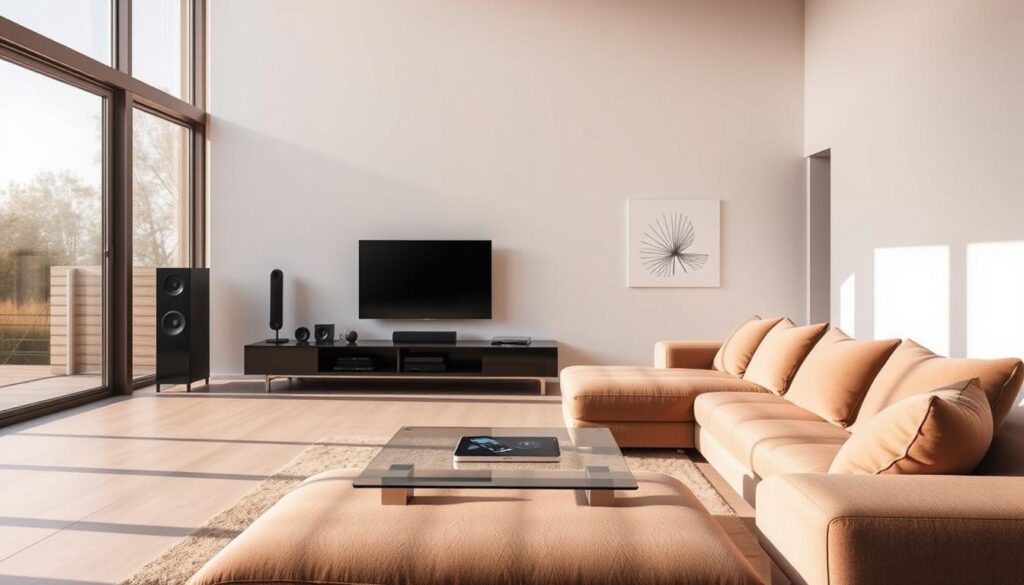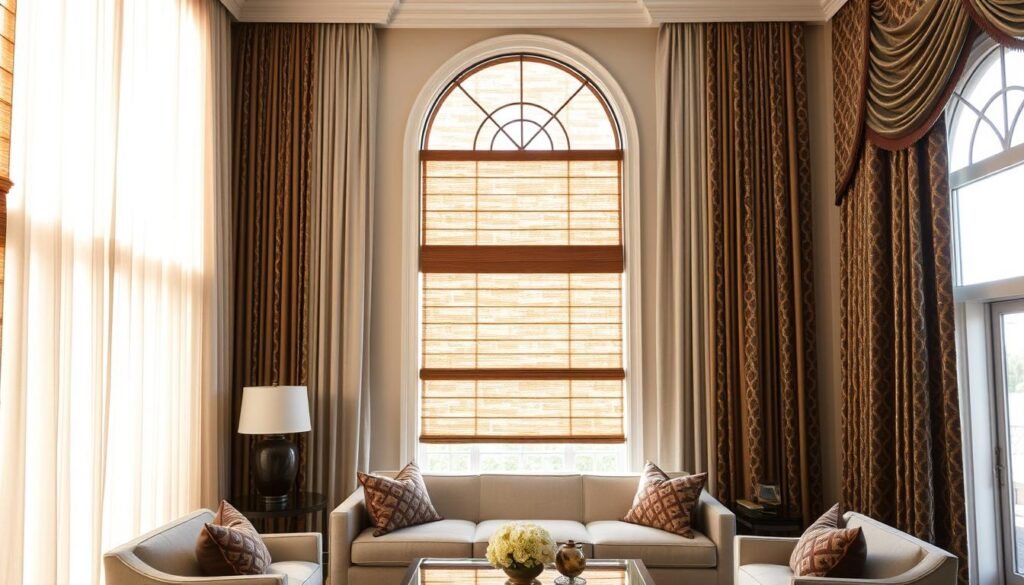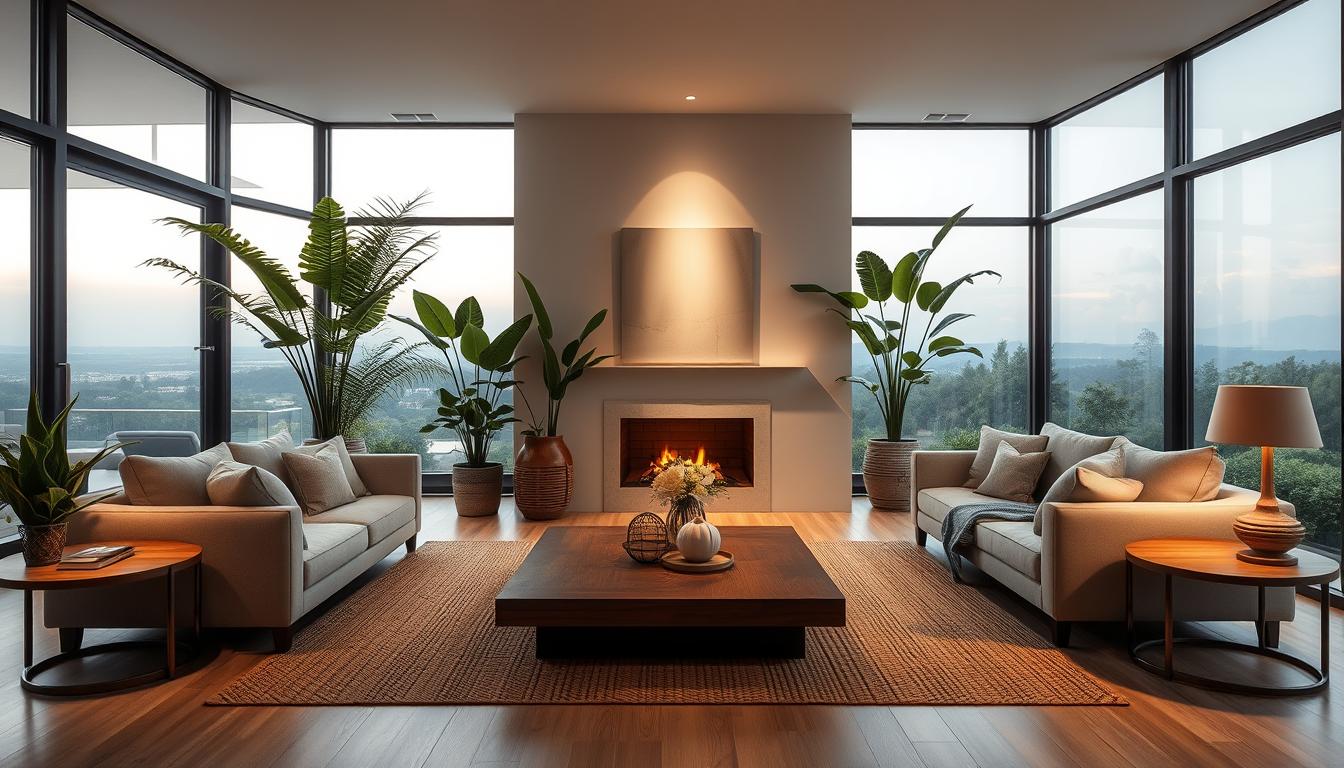When we talk about ‘elevating’ a space, we mean making it work perfectly. We think about every detail, from the rug to the lights, to get a unified look.
Elevating your space is more than just making it look good. It’s about making it both beautiful and useful. We pick each item carefully to make sure they all go together well, without looking too done-up.
By focusing on cohesive design, we can turn a living area into a cozy spot that shows off our style and still works well.
Key Takeaways
- Create a cohesive look by considering every element in the room.
- Balance aesthetics with functionality.
- Use lighting and rugs to enhance the overall atmosphere.
- Avoid over-styling to maintain a welcoming feel.
- Reflect your personal style through your design choices.
Choosing the Right Color Palette for Your Living Room
A well-chosen color palette is key to a stylish and welcoming living room. The colors you pick greatly affect the room’s feel and look.
Understanding Color Psychology
Colors can make us feel certain ways. For example, deep jewel shades like emerald green add sophistication. Knowing how colors work can guide your choices.
- Cool colors like blues and greens calm the space.
- Warm colors such as oranges and reds spark conversation.
- Neutrals like beige and gray are great for mixing with other colors.
For more ideas on living room colors, check out BHG’s guide on living room color.
Popular Color Trends for 2024
Keeping up with color trends ensures your palette is modern and stylish. Here are some 2024 favorites:
- Deep, rich colors add luxury and depth.
- Soft pastels create a soothing atmosphere.
- Earth tones warm up the room.
Tips for Mixing and Matching Colors
Mixing colors can be tricky, but with some advice, you can achieve a beautiful palette:
- Begin with a neutral base and add color with furniture and decor.
- Use a color wheel to find colors that go well together.
- Follow the 60-30-10 rule: 60% main color, 30% secondary, and 10% accent.
Selecting the Perfect Furniture
Choosing the right furniture is key to a great living room. Start with the sofa, as it’s the biggest piece and sets the room’s style.
Key Factors for Furniture Size and Arrangement
Furniture size and arrangement are vital for a room’s flow and function. Think about the room’s size and how many people it will hold. A well-planned room can make a small space feel bigger and more welcoming.
| Furniture Piece | Size Consideration | Arrangement Tip |
|---|---|---|
| Sofa | Proportionate to the room size | Place against a wall, leaving space for traffic |
| Coffee Table | Complementary to the sofa size | Centered in front of the sofa |
| Armchairs | Balancing the scale of the sofa | Placed to create conversational circles |
Cozy vs. Modern: Different Styles to Consider
The furniture style greatly affects your living room’s feel. You can choose a cozy, traditional look or a sleek, modern design. Pick a style that shows your taste and fits the room’s architecture.
Choosing Multi-Functional Furniture
Today, multi-functional furniture is popular for its practicality and space-saving. Opt for pieces like storage ottomans or coffee tables with storage. They keep the room tidy while keeping it stylish.
By thinking about these factors and styles, we can make a living room that’s beautiful, functional, and comfy. The right furniture is essential for a space that feels welcoming and harmonious.
Lighting: The Key to Ambiance
Ambiance in a living room is mostly about the lighting. Good lighting makes a room cozy and inviting. Bad lighting can make it dull and unwelcoming.
When setting up lighting for a living room, think about how it will be used. Reading needs focused light, while TV watching prefers softer light.
Types of Lighting: Ambient, Task, and Accent
There are three main lighting types for a living room:
- Ambient Lighting: This lights up the whole room, making it safe to move around.
- Task Lighting: It shines on areas for specific tasks, like reading or cooking.
- Accent Lighting: It highlights certain features or objects, like art or details.
How to Layer Your Lighting Effectively
Layering lighting means mixing ambient, task, and accent lights for a good look and function. Here’s how to do it:
- Begin with ambient lighting to set the room’s mood.
- Add task lighting where needed, like table lamps for reading.
- Accent lighting brings out special features or adds interest.
Choosing the Right Light Fixtures
Picking the right light fixtures is key for the right vibe. Think about the style, size, and type that fits your space. For example, a modern room might need sleek fixtures, while a traditional room might look better with ornate ones.
Understanding different lighting types and how to mix them helps create a room that’s both useful and looks great.
Adding Texture and Depth
Adding different textures and elements can make your living room feel special. A well-designed space looks good and feels welcoming. Texture and depth are key to achieving this.
The Role of Fabrics in Interior Design
Fabrics are very important in interior design. They add texture and feel to a room. Think about using plush rugs and soft throw blankets for warmth and coziness.
Using a mix of fabric textures like velvet, linen, and cotton can create a layered look. For example, a velvet sofa with linen curtains and a cotton rug can make your room inviting. The goal is to mix textures to avoid a dull feel.
Mixing Textures for a Cozy Feel
Mixing textures can make your living room cozy and welcoming. Combining wood, metal, and fabric adds depth and interest. For instance, a wooden coffee table with metal accents and a fabric sofa creates a harmonious mix.
| Texture | Examples | Benefits |
|---|---|---|
| Soft Fabrics | Throw blankets, pillows | Adds warmth and coziness |
| Natural Materials | Wood, stone | Brings a sense of nature indoors |
| Metal Accents | Lighting fixtures, decorative items | Adds a touch of modernity |
Incorporating Natural Elements
Adding natural elements can enhance your living room’s texture and depth. Plants not only purify the air but also add greenery. Wood and stone can be used in furniture and decor.
For a cozy living room, combine these elements with soft lighting and comfy seating. This creates a warm, inviting space that feels connected to nature.
Personalizing Your Space with Art
Art is more than decoration; it tells your story in your living space. By picking art that speaks to you, your living room becomes a warm, inviting place. It shows off your personality.
Selecting Art That Resonates with You
Think about art that stirs emotions or brings back memories. This could be a painting, photo, or sculpture that touches you. The goal is to pick art that makes you feel something. It adds depth to your living room.
A vibrant abstract painting can energize the room. A calm landscape photo can make it peaceful. Choose art that shows your tastes and interests.
Creating an Art Gallery Wall
An art gallery wall is a great way to show off many art pieces. It adds interest to your living room. Start by picking a theme or color scheme for the art.
For a lively look, mix frame styles and sizes. But keep a common thread, like color or material, to connect the pieces. For tips on hanging art, check out Emily Henderson’s guide.
Using Frames and Display Techniques
The right frames and display methods can make your art stand out. Choose frames that match your room’s style, whether it’s modern, traditional, or eclectic.
| Frame Style | Suitable Art Style | Living Room Style |
|---|---|---|
| Modern Minimalist | Abstract, Contemporary | Modern, Scandinavian |
| Ornate | Classical, Traditional | Traditional, Luxurious |
| Reclaimed Wood | Rustic, Earthy | Rustic, Coastal |
By carefully choosing art and frames, you can make a living room that’s both beautiful and personal.
Incorporating Technology into Living Rooms
Our living rooms are getting smarter with new gadgets and systems. This makes our entertainment better and daily life easier.

Smart Home Gadgets for Convenience
Smart home gadgets make your living room more functional. They include voice-controlled assistants and smart lighting. These gadgets make life simpler and more convenient.
- Amazon Echo or Google Home for voice control
- Smart light bulbs that adjust based on the time of day
- Smart thermostats for temperature control
You can control these gadgets with your smartphone. This lets you adjust settings even when you’re away.
Designing for Entertainment: TVs and Speakers
The TV and sound system are key for entertainment in the living room. Here are some tips:
- Choose a TV that fits the room’s dimensions and seating arrangement.
- Invest in a soundbar or home theater system for enhanced audio.
- Consider the placement of speakers to achieve optimal sound distribution.
Remember, the TV should not be the only focus. Balance it with other decor for a harmonious space.
Concealment Options for Wires and Cables
Managing wires and cables is a challenge when adding technology to your living room. Here are some solutions:
- Cable management boxes to hide cables and adapters
- Wire concealment strips or channels to run cables along walls or under furniture
- Wireless charging pads to reduce clutter from charging cables
These options help keep your space clean and organized. You can enjoy your technology without the mess.
Creating a Functional Layout
Designing a living room that looks good and works well starts with a good layout. A well-thought-out layout makes your living room look better and use space better.
Traffic Flow: Ensuring Easy Navigation
One key part of a good layout is making it easy to move around. Arrange furniture so it doesn’t block the way. Avoid cluttering the room with too many pieces, as this can make it hard to move. Instead, choose a simple design that focuses on function.
Zoning: Defining Spaces for Different Activities
Zoning is also crucial for a functional layout. It means dividing the room into areas for different activities, like reading or watching TV. Using area rugs and lighting can help make these zones clear without needing walls.
Open vs. Closed Living Areas
Choosing between an open or closed living area depends on what you like and need. Open-plan areas can make a room feel bigger and more connected. Closed areas can be cozier and more private. Think about your lifestyle and home layout when deciding.
In the end, finding the right layout is about finding a balance. Consider how people will move, the different zones, and how open the area is. This way, you can create a space that looks great and works well.
Accessorizing Your Living Room
The right accessories can make your living room more inviting and personal. They add texture, color, and interest. This turns your space into a cozy, welcoming place.
Must-Have Decorative Items
There are key decorative items to consider for accessorizing. These include vases, sculptures, and objects that show your style. Throw pillows and blankets are also key, adding color and texture to your furniture.
For a cohesive look, pick items that match your color palette and furniture style. For example, modern furniture calls for sleek, minimalist decor.
Plants and Greenery: Adding Life to Your Space
Adding plants and greenery can greatly improve your living room’s feel. Plants purify the air and bring a natural touch. Choose low-maintenance plants like succulents or snake plants if you’re new to plant care.
To make a big impact, group plants or place them on decorative stands. This creates a lush, inviting atmosphere.
Seasonal Decor Changes
Changing your decor with the seasons keeps your living room fresh and interesting. For example, add woolen throws and candles in winter, or seashells and floral arrangements in spring.
| Season | Decor Ideas |
|---|---|
| Spring | Floral arrangements, pastel colors, light fabrics |
| Summer | Seashells, nautical themes, bright colors |
| Autumn | Pumpkins, warm-toned leaves, cozy throws |
| Winter | Candles, woolen decor, evergreen branches |
By using these accessorizing tips, you can make a living room that’s beautiful and reflects your personality and style.
Window Treatments That Wow
The right window treatments can change your living room. They add elegance and sophistication. Window treatments are not just useful; they also tie a room’s look together.

Types of Window Treatments to Consider
There are many window treatments to pick from. Each has its own benefits and styles. Here are some popular ones:
- Curtains and drapes add luxury and come in many materials and patterns.
- Blinds offer a simple look and let you control light.
- Shades are versatile, from roller to Roman shades.
- Shutters are a classic choice and last long.
Practical vs. Aesthetic Choices
Choosing window treatments means balancing what’s useful with what looks good. If you have kids or pets, pick durable, easy-to-clean options. For a style statement, choose treatments that match your room’s colors and decor. For more help, check out our services.
How to Measure for Window Treatments
Getting the right measurements is key for a perfect fit. Start by measuring your window’s width and length. Think about whether you want an inside or outside mount, as this changes your measurements.
For an inside mount, measure the width at the top, middle, and bottom. Use the smallest measurement. For the length, measure from the top to where you want the treatment to end, like the sill or floor.
By choosing wisely and measuring well, you can find treatments that make your living room look and feel better. For example, full-height curtains can make a room feel cozy and inviting.
Flooring Options: What’s Best for You?
Flooring is more than just covering the floor. It sets the style and comfort of your living room. Choosing the right flooring is key to your home’s look and feel.
Pros and Cons of Different Flooring Types
Each flooring type has its own good and bad points. Hardwood floors are durable and stylish but can be pricey and get scratched easily. Laminate floors are cheaper and don’t scratch as much, but they don’t look as real as hardwood.
| Flooring Type | Pros | Cons |
|---|---|---|
| Hardwood | Durable, timeless appeal | Expensive, susceptible to scratches |
| Laminate | Budget-friendly, scratch-resistant | Less authentic look |
| Tile | Water-resistant, easy to clean | Can be cold, hard |
Area Rugs: Adding Comfort and Style
Area rugs do more than just cover the floor. They define the space, add warmth, and make it cozier. The right rug can tie the room’s look together and make it feel warmer.
Benefits of Area Rugs:
- Adds warmth and coziness
- Defines different areas within the room
- Provides acoustic insulation
- Enhances the room’s aesthetic
Maintenance Tips for Each Flooring Option
Keeping your floors in good shape is important. Hardwood floors need regular sweeping and sometimes refinishing. Laminate floors should be cleaned with a damp mop often. Tile floors require grout care to avoid dirt buildup.
Regular care keeps your floors looking great and lasting longer.
Sustainable Choices for Eco-Friendly Design
Creating an eco-friendly living room is more than just about looks. It’s about making choices that help the planet. We’ll look at materials, practices, and strategies to reduce our environmental impact.
Eco-Friendly Materials to Consider
The materials we choose are key in sustainable design. Eco-friendly materials are those that are good for the planet. Examples include:
- Bamboo flooring, which is renewable and durable.
- Recycled glass countertops, offering a unique look and reducing waste.
- Sustainably sourced wood, like reclaimed or FSC-certified wood, for furniture and decor.
Using these materials supports sustainable forestry and reduces waste. They also add a unique touch to your living room.
The Benefits of Upcycling Furniture
Upcycling furniture is a creative way to reduce waste. Upcycling turns old furniture into something new and useful. This approach cuts down on landfill waste and saves resources.
| Benefits | Description |
|---|---|
| Environmental Impact | Reduces waste and conserves resources. |
| Unique Designs | Creates unique pieces that add character to your space. |
| Cost-Effective | Often cheaper than buying new, high-quality furniture. |
Tips for Energy Efficiency in Design
Energy efficiency is vital in sustainable design. By adding energy-efficient solutions to your living room, you can cut down on energy use and lower bills.
- Use LED lighting, which is more energy-efficient than traditional lighting.
- Invest in smart home devices to monitor and control energy usage.
- Choose energy-efficient appliances and electronics when shopping.
By choosing sustainable options, we can make living rooms that are both beautiful and good for the planet.
Final Touches: Bringing It All Together
As we wrap up our guide to improve your living room, it’s key to focus on the final details. These details are what make your space complete. A well-designed room needs everything to work together seamlessly.
Cohesion in Design
To achieve cohesion, balance color, texture, and furniture. Adding layers of color and contrast makes your living room look great. It creates a beautiful atmosphere.
Making Last-Minute Adjustments
When you’re done with your living room, step back and look at it. Make any changes needed to make the room feel welcoming and balanced.
Celebrating Your New Space
Now that your living room is done, it’s time to enjoy it. The final touches have made your space perfect for both relaxing and having fun.


